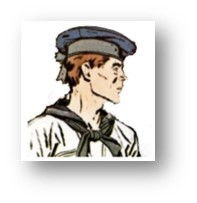Name: Arrowsmith, Edwin, coal heaver, US Navy
Local address: Main Street, Middletown Point. 1850 and 1860 maps show the family homestead to be between Church and Spring on Main Street.
Edwin, born in 1842, was one of five children of Thomas Henry Arrowsmith (1803-1895) and Ann Eliza Bedle (1808-1885). Thomas was a prominent Matawan citizen who served as the local undertaker – mother Eliza was the aunt of New Jersey Governor Joseph Dorsett Bedle.
The 1860 census listed Edwin, 18 at the time, apprenticed to his father as a cabinet maker (early undertaking businesses were often an adjunct concern of cabinet makers and woodworkers.)
On June 13, 1863, Edwin enlisted in the US Navy in New York City. The record indicated he was from Monmouth County, with hazel eyes, brown hair, fair complexion and stood 5’ 6 ½ inches tall and was 21 years of age. He had no scars or tattoos (a surprisingly large number of the other 70 men who enlisted that day had nautical-themed tattoos.) His previous occupation was listed as “blacksmith” and he was rated as “coal heaver” which in today’s navy would most likely be a boiler technician. His job would be to maintain a steady flow of fuel to power steam engines on naval warships. Records indicate that on November 18, 1863, he was assigned to the armored warship New Ironsides assigned to the North Atlantic Blockading Squadron.
The ship was an ironclad steamer with a displacement 3,486 tons, length 230′, beam 57’6″and a draft of15’8″. It could steam at 8 knots, had a complement 449 and had been launched the previous May. Armed with 14 × 11-inch (279 mm) smoothbore Dahlgren guns, 2 × 150-pounder Parrott rifles and 2 × 50-pounder Dahlgren rifles, and with almost 5” of belt and battery armor, she was a formidable vessel.
Its initial duties were to guard the wooden-hulled warships blockading Charleston harbor against rebel ironclads. It also was engaged in the constant bombardments of Ft. Wagner, which guarded the harbor. Although repeatedly struck by enemy cannonballs, the ship was relatively unscathed. In the final attack on the fort in late August 1863, over 100 confederate defenders were killed, and the enemy was forced to withdraw.
After being damaged by an enemy torpedo boat in October, she continued the blockade until the following May, when she returned to Philadelphia for repair. In August of 1864 the ship resumed her duties by blockading Norfolk and later bombarded Ft. Fisher which protected Wilmington, NC.
There were two battles of Ft. Fisher. In the 1st, which occurred between December 24 and 27, 1864, troops, most likely supplemented by marines and sailors, were landed but were later withdrawn when rumored rebel reinforcements were believed to be on the way. In the 2nd battle in mid-January of 1865, the fleet contributed a landing party of around 3000 sailors and marines to supplement 8000 army forces.
Edwin most likely participated in the initial assault and was captured, because he reportedly died in a confederate POW camp in Salisbury, NC on January 2, 1865.There is also the possibility that he was involved in an earlier landing party prior to these battles and was captured. Further research is being conducted to gather additional information.
There is a marker for Edwin in Matawan’s Rose Hill Cemetery, which was opened in 1858. It is unclear if his body is buried here, or if it is just a memorial – the marker also lists another brother who died in 1848. Although his father was affluent and could have the means to have his body located and returned to New Jersey, most captured Union troops who died in southern prison camps were buried in unmarked graves on the premises.


NO COMMENTS